
Chapter 8: Electricity
They are two and opposite types of electric charges.
negative (-); and
positive (+)
Like charges repel; unlike charges attract.
The closer the charge, the greater the force between them.
Conductors are materials that let electrons pass through them.
Free electrons make metals good thermal and electrical conductors.
Insulators are materials that hardly conduct at all.
Their electrons are tightly held to atoms and are not free to move - although they can be transferred by rubbing.
Semiconductors are ‘‘in between’’ materials. They are poor conductors when cold, but much better conductors when warm.
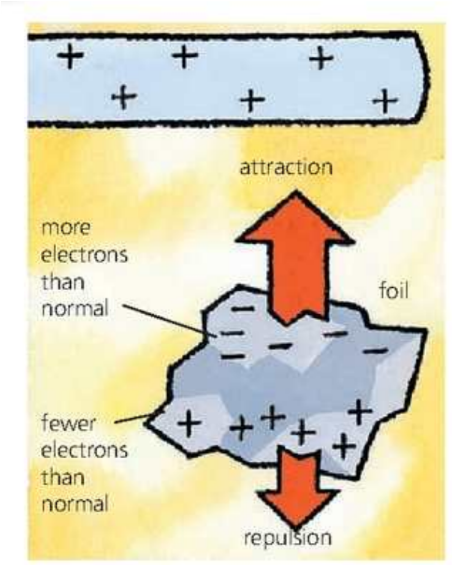
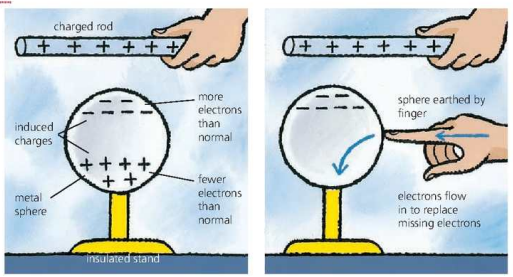
Electrostatic precipitators
Photocopiers
Laser Printers
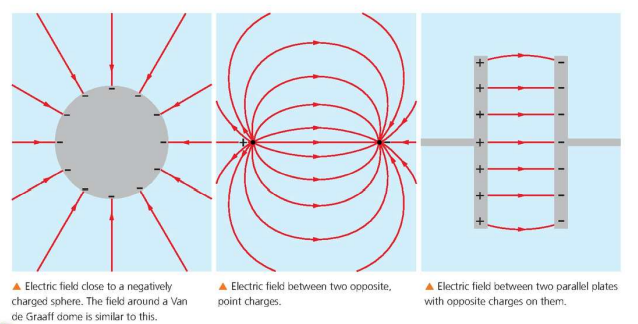
Flow of charge is an electric current.
SI unit is Amperes (A)
Measured by connecting an ammeter.
In a simple circuit current is same at all points.

Is also known as Voltage. It is the work done per unit charge in moving between two points in a circuit.
SI unit is Volts (V).
Measured using a Voltmeter.
Higher the voltage greater the current.
Moving round a circuit, from on battery terminal to the other, the sum of potential differences across the components is equal to the potential difference across the battery.
Resistance of a component is given by the potential difference across it divided by the current through it.
The greater the resistance, the harder it is for current to flow through the component.
Factors affecting resistance:
Length - doubling the length of a wire doubles resistance.
Cross-Sectional Area - halving the 'end on' area of a wire doubles its resistance.
So a thin wire has more resistance than a thick one.
Material - a nichrome wire has more resistance than a copper wire of the same size.
Temperature - for metal conductors, resistance increases with temperature. For semiconductors, it decreases with temperature.
Resistors are specially made to provide resistance. In simple circuits, they reduce the current. In more complicated circuits, such as those in radios, TVs, and computers, they keep currents and p.d.s at the levels needed for other components (parts) to work properly.
Like all resistances, resistors heat up when a current flows in them. However, if the current is small, the heating effect is slight.
Variable resistors (rheostats) are used for varying current. The one on the right is controlling the brightness of a lamp. In hi-fi equipment, rotary (circular) variable resistors are used as volume controls.
Thermistors have a high resistance when cold but a much lower resistance when hot. They contain semiconductor materials. Some electrical thermometers use a thermistor to detect temperature change.
Light-dependent resistors (LDRS) have a high resistance in the dark but a low resistance in the light. They can be used in electronic circuits which switch lights on and off automatically.
Diodes have an extremely high resistance in one direction but a low resistance in the other. In effect, they allow current to low in one direction only. They are used in electronic circuits.

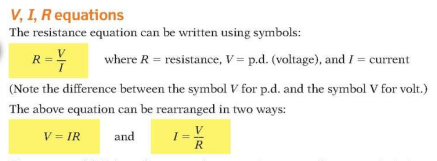
In an ohmic conductor, the current is directly proportional to the voltage (ie. it has constant resistance). In a non-ohmic conductor (such as a filament lamp), the resistance changes as the voltage and current change.
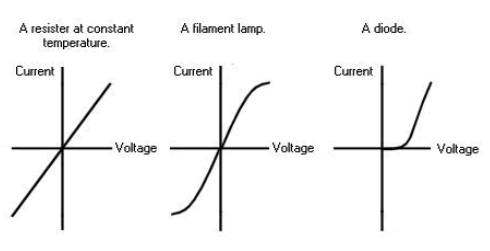 Series and Parallel Circuits
Series and Parallel Circuits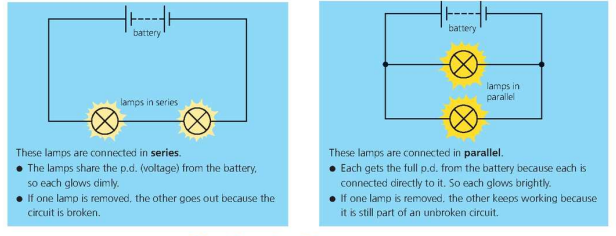
If two (or more) resistors are connected in series, they give a higher resistance than any of the resistors by itself. The effect is the same as joining several lengths of resistance wire to form a longer length.
Given by the following equation:
![]()
If two (or more) resistors are connected in parallel, they give a lower resistance than any of the resistors by itself. The effect is the same as using a thick piece of resistance wire instead of a thin one. There is a wider conducting path than before.
Given by the following equation:
![]()
Power is the rate at which energy is transferred. SI unit is Watts (W).
Given by the equation:
![]()



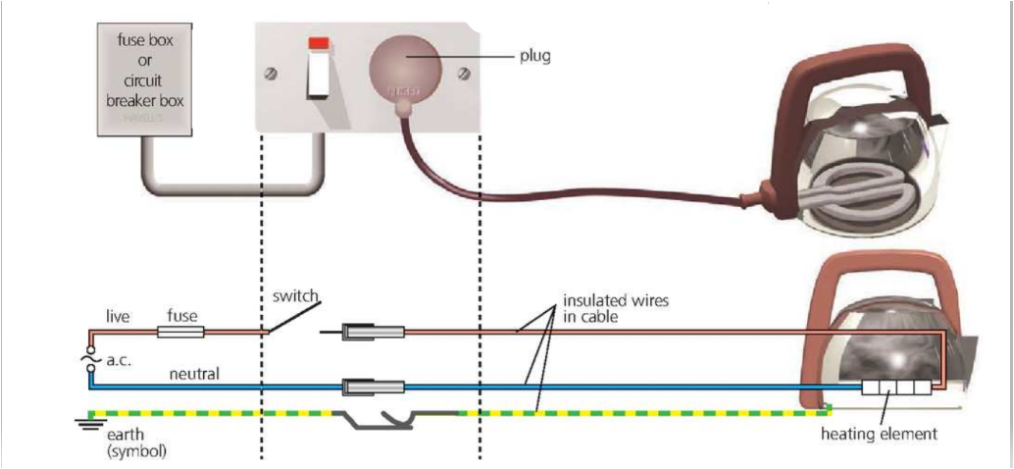
Live Wire - this goes alternately negative and positive, making the current flow backwards and forwards in the circuit.
Neutral Wire - this completes the circuit. In many circuits, it is kept at zero voltage by the electricity supply.
Switch - this fitted in the live wire.
Fuse - this is a thin piece of wire which overheats and melts if the current in circuit is too high.
It is placed in the live wire; if a fault develops, and the current is too high, the fuse blows and breaks the circuit before the cable can overheat and catch fire.
Earth Wire - this is a safety wire.
If the live wire comes loose and touches the metal body, a current immediately flows to earth and blows the fuse. This would make the metal body safe.
Old, frayed wiring. Broken strands mean that a wire will have a higher resistance at one point. When a current flows in it, the heating effect may be enough to melt the insulation and cause a fire.
Long extension leads. These may overheat if used when coiled up. The current warms the wire, but the heat has less area to escape from a tight bundle.
Water in sockets or plugs. Water will conduct a current, so if electrical equipment gets wet, there is a risk that someone might be electrocuted.
Accidentally cutting cables. With lawnmowers and hedge trimmers, a plug-in RCD can be used to avoid the risk of electrocution.
They are two and opposite types of electric charges.
negative (-); and
positive (+)
Like charges repel; unlike charges attract.
The closer the charge, the greater the force between them.
Conductors are materials that let electrons pass through them.
Free electrons make metals good thermal and electrical conductors.
Insulators are materials that hardly conduct at all.
Their electrons are tightly held to atoms and are not free to move - although they can be transferred by rubbing.
Semiconductors are ‘‘in between’’ materials. They are poor conductors when cold, but much better conductors when warm.


Electrostatic precipitators
Photocopiers
Laser Printers

Flow of charge is an electric current.
SI unit is Amperes (A)
Measured by connecting an ammeter.
In a simple circuit current is same at all points.

Is also known as Voltage. It is the work done per unit charge in moving between two points in a circuit.
SI unit is Volts (V).
Measured using a Voltmeter.
Higher the voltage greater the current.
Moving round a circuit, from on battery terminal to the other, the sum of potential differences across the components is equal to the potential difference across the battery.
Resistance of a component is given by the potential difference across it divided by the current through it.
The greater the resistance, the harder it is for current to flow through the component.
Factors affecting resistance:
Length - doubling the length of a wire doubles resistance.
Cross-Sectional Area - halving the 'end on' area of a wire doubles its resistance.
So a thin wire has more resistance than a thick one.
Material - a nichrome wire has more resistance than a copper wire of the same size.
Temperature - for metal conductors, resistance increases with temperature. For semiconductors, it decreases with temperature.
Resistors are specially made to provide resistance. In simple circuits, they reduce the current. In more complicated circuits, such as those in radios, TVs, and computers, they keep currents and p.d.s at the levels needed for other components (parts) to work properly.
Like all resistances, resistors heat up when a current flows in them. However, if the current is small, the heating effect is slight.
Variable resistors (rheostats) are used for varying current. The one on the right is controlling the brightness of a lamp. In hi-fi equipment, rotary (circular) variable resistors are used as volume controls.
Thermistors have a high resistance when cold but a much lower resistance when hot. They contain semiconductor materials. Some electrical thermometers use a thermistor to detect temperature change.
Light-dependent resistors (LDRS) have a high resistance in the dark but a low resistance in the light. They can be used in electronic circuits which switch lights on and off automatically.
Diodes have an extremely high resistance in one direction but a low resistance in the other. In effect, they allow current to low in one direction only. They are used in electronic circuits.


In an ohmic conductor, the current is directly proportional to the voltage (ie. it has constant resistance). In a non-ohmic conductor (such as a filament lamp), the resistance changes as the voltage and current change.
 Series and Parallel Circuits
Series and Parallel Circuits
If two (or more) resistors are connected in series, they give a higher resistance than any of the resistors by itself. The effect is the same as joining several lengths of resistance wire to form a longer length.
Given by the following equation:
![]()
If two (or more) resistors are connected in parallel, they give a lower resistance than any of the resistors by itself. The effect is the same as using a thick piece of resistance wire instead of a thin one. There is a wider conducting path than before.
Given by the following equation:
![]()
Power is the rate at which energy is transferred. SI unit is Watts (W).
Given by the equation:
![]()




Live Wire - this goes alternately negative and positive, making the current flow backwards and forwards in the circuit.
Neutral Wire - this completes the circuit. In many circuits, it is kept at zero voltage by the electricity supply.
Switch - this fitted in the live wire.
Fuse - this is a thin piece of wire which overheats and melts if the current in circuit is too high.
It is placed in the live wire; if a fault develops, and the current is too high, the fuse blows and breaks the circuit before the cable can overheat and catch fire.
Earth Wire - this is a safety wire.
If the live wire comes loose and touches the metal body, a current immediately flows to earth and blows the fuse. This would make the metal body safe.
Old, frayed wiring. Broken strands mean that a wire will have a higher resistance at one point. When a current flows in it, the heating effect may be enough to melt the insulation and cause a fire.
Long extension leads. These may overheat if used when coiled up. The current warms the wire, but the heat has less area to escape from a tight bundle.
Water in sockets or plugs. Water will conduct a current, so if electrical equipment gets wet, there is a risk that someone might be electrocuted.
Accidentally cutting cables. With lawnmowers and hedge trimmers, a plug-in RCD can be used to avoid the risk of electrocution.